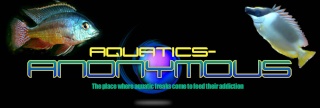[You must be registered and logged in to see this image.]
Bristlenose Pleco/Ancistrus temminckii
Like many plecos, they love to eat algae. I have read that some aquarists say that bristlenose plecos are the best "cure" for algae problems. Bristlenose's do a good job on attached algae and only grow to 4 to 8 inches depending on the species. Ancistrus temminckii grows only up to about 4.75 inches. Compared to other plecos who grow to 1 to 2 feet, that is small!
These plecos are named after their mustache, or bristlenose, the little feelers that stick out from their face.
Bristlenose plecostomus are perhaps the easiest plecostomus to breed in an aquarium. When sexually mature, a male will find a suitable spawning location and claim it as his territory. This may be around or under a hunk of driftwood or inside or under PVC pipe or clay pots. He will defend the spot from other males if present. To promote spawning, Baensch's aquarium atlas suggests doing a 75% water change in November (in the Northern hemisphere). The shorter days of winter and the water change make the plecos think it is the start of the rainy season. If the tank has a female(s), she will enter his territory and spawning site when she is ready to lay eggs. Eggs are stuck on hard surfaces, on top, hanging from the "ceiling." The camouflaged male will guard the orange or amber eggs until they hatch about ten days later. After absorbing their yolk over three to four days, the tiny, baby plecos will immediately start to work on sucking algae off of surfaces. If there are other fish in the tank aside from the plecos, the babies or eggs can be moved to another tank to prevent those fish from eating the babies. Some breeders remove whatever the eggs are laid on into another tank and give the father a replacement site (wood, pot, PVC, etc.) to guard. Although I have not bred these fish, I would think it would be better to keep the eggs with the father so that he can aerate them and tend to them. The babies can be removed after hatching.
Maximum Size: 5 inches
Life Span: 20 years
Natural Habitat: South American rivers and streams
Minimum Tank Size: 20 gallons
Temperature Range: 62°F - 80°F
pH Range: 5.8 - 7.6
Hardness: 5° - 20°
Tank Region: Bottom
Possible Tank Mates: Community fish. Can work with smaller cichlid species.
Sexing Information: Males have larger bristles and grow more rapidly.
Diet: Vegetarian - eats algae and algae wafers. Suppliment with fresh vegetables such as zucchini slices, rommaine lettuce or spinach.
Temperment: Peaceful; Peaceful, and quite sociable. Excellent for community tanks.
Bristlenose Pleco/Ancistrus temminckii
Like many plecos, they love to eat algae. I have read that some aquarists say that bristlenose plecos are the best "cure" for algae problems. Bristlenose's do a good job on attached algae and only grow to 4 to 8 inches depending on the species. Ancistrus temminckii grows only up to about 4.75 inches. Compared to other plecos who grow to 1 to 2 feet, that is small!
These plecos are named after their mustache, or bristlenose, the little feelers that stick out from their face.
Bristlenose plecostomus are perhaps the easiest plecostomus to breed in an aquarium. When sexually mature, a male will find a suitable spawning location and claim it as his territory. This may be around or under a hunk of driftwood or inside or under PVC pipe or clay pots. He will defend the spot from other males if present. To promote spawning, Baensch's aquarium atlas suggests doing a 75% water change in November (in the Northern hemisphere). The shorter days of winter and the water change make the plecos think it is the start of the rainy season. If the tank has a female(s), she will enter his territory and spawning site when she is ready to lay eggs. Eggs are stuck on hard surfaces, on top, hanging from the "ceiling." The camouflaged male will guard the orange or amber eggs until they hatch about ten days later. After absorbing their yolk over three to four days, the tiny, baby plecos will immediately start to work on sucking algae off of surfaces. If there are other fish in the tank aside from the plecos, the babies or eggs can be moved to another tank to prevent those fish from eating the babies. Some breeders remove whatever the eggs are laid on into another tank and give the father a replacement site (wood, pot, PVC, etc.) to guard. Although I have not bred these fish, I would think it would be better to keep the eggs with the father so that he can aerate them and tend to them. The babies can be removed after hatching.
Maximum Size: 5 inches
Life Span: 20 years
Natural Habitat: South American rivers and streams
Minimum Tank Size: 20 gallons
Temperature Range: 62°F - 80°F
pH Range: 5.8 - 7.6
Hardness: 5° - 20°
Tank Region: Bottom
Possible Tank Mates: Community fish. Can work with smaller cichlid species.
Sexing Information: Males have larger bristles and grow more rapidly.
Diet: Vegetarian - eats algae and algae wafers. Suppliment with fresh vegetables such as zucchini slices, rommaine lettuce or spinach.
Temperment: Peaceful; Peaceful, and quite sociable. Excellent for community tanks.



